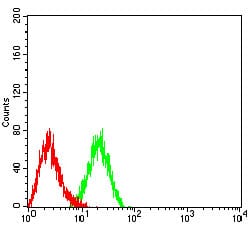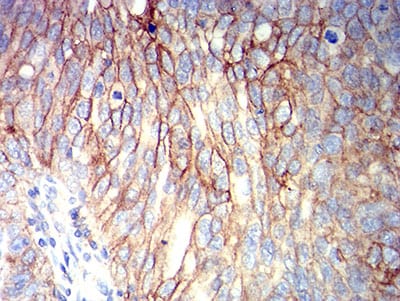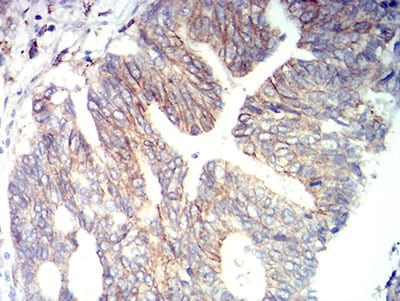



| WB | 1/500 - 1/2000 | Human,Mouse,Rat |
| IF | 咨询技术 | Human,Mouse,Rat |
| IHC | 1/200 - 1/1000 | Human,Mouse,Rat |
| ICC | 技术咨询 | Human,Mouse,Rat |
| FCM | 1/200 - 1/400 | Human,Mouse,Rat |
| Elisa | 1/10000 | Human,Mouse,Rat |
| Aliases | MEMD; ALCAM |
| Entrez GeneID | 214 |
| clone | 2F1B12 |
| WB Predicted band size | 65kDa |
| Host/Isotype | Mouse IgG1 |
| Antibody Type | Primary antibody |
| Storage | Store at 4°C short term. Aliquot and store at -20°C long term. Avoid freeze/thaw cycles. |
| Species Reactivity | Human |
| Immunogen | Purified recombinant fragment of human CD166 (AA: extra 227-381) expressed in E. Coli. |
| Formulation | Purified antibody in PBS with 0.05% sodium azide |
+ +
以下是3-4条关于CD166抗体的参考文献及其摘要内容的简要概括:
---
1. **文献名称**:*CD166/ALCAM expression is associated with tumorigenesis and therapeutic resistance in colorectal cancer*
**作者**:Kristiansen G, et al.
**摘要**:该研究揭示了CD166在结直肠癌干细胞中的高表达,其与肿瘤侵袭性和化疗耐药性相关。通过CD166抗体的检测,可评估患者预后及靶向治疗潜力。
2. **文献名称**:*ALCAM/CD166 mediates immune cell infiltration and progression of head and neck squamous cell carcinoma*
**作者**:Swart GW, et al.
**摘要**:本文探讨CD166在头颈部鳞癌中促进免疫细胞浸润的作用,并利用抗体阻断实验证明其调控肿瘤微环境及转移的机制。
3. **文献名称**:*Targeting CD166+ lung cancer stem cells with monoclonal antibodies inhibits tumor growth*
**作者**:Ohneda O, et al.
**摘要**:研究开发了一种靶向CD166的单克隆抗体,在肺癌小鼠模型中显著抑制肿瘤生长并减少干细胞样细胞群,提示其治疗潜力。
4. **文献名称**:*CD166 as a surface marker for isolation of mesenchymal stromal cells with enhanced differentiation and immunomodulatory capacity*
**作者**:Lv FJ, et al.
**摘要**:该文献提出CD166抗体可用于高效分选间充质干细胞(MSCs),这类细胞表现出更强的成骨分化能力和免疫调节功能,为再生医学提供新策略。
---
以上文献涵盖了CD166在癌症、干细胞及免疫调控中的关键作用,以及抗体在诊断和治疗中的应用。如需具体文章,建议通过PubMed或期刊数据库检索标题或作者进一步获取。
CD166. also known as Activated Leukocyte Cell Adhesion Molecule (ALCAM), is a transmembrane glycoprotein belonging to the immunoglobulin superfamily. It plays critical roles in cell-cell adhesion, immune response modulation, and cellular signaling. Structurally, CD166 contains five extracellular immunoglobulin-like domains, a transmembrane region, and a cytoplasmic tail. It mediates both homophilic (CD166-CD166) and heterophilic (CD166-CD6) interactions, facilitating processes like T-cell activation, neuronal development, and cancer cell migration.
CD166 antibodies are essential tools for studying its expression and function. In research, these antibodies are used in techniques such as flow cytometry, immunohistochemistry, and Western blotting to detect CD166 in tissues or cells. Elevated CD166 expression is linked to various cancers, including breast, colon, and melanoma, where it often correlates with tumor progression, metastasis, and cancer stem cell activity. Conversely, in some contexts, CD166 may act as a tumor suppressor, highlighting its context-dependent roles.
Clinically, CD166 antibodies hold diagnostic and therapeutic potential. They serve as biomarkers for cancer prognosis and are explored in targeted therapies, such as antibody-drug conjugates or immune checkpoint modulation. Additionally, CD166's involvement in autoimmune diseases and transplant rejection has spurred interest in blocking its interactions with CD6 to regulate immune responses. Both monoclonal and polyclonal CD166 antibodies are commercially available, with specificity and applications varying by clone and epitope recognition. Ongoing research aims to clarify its dual roles and optimize therapeutic strategies leveraging CD166 targeting.
×